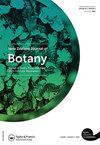布莱恩·彼得·约翰·莫洛伊(1930年8月12日- 2022年7月31日):野外生态学家、植物学家和自然资源保护学家
IF 1.4
4区 生物学
Q4 PLANT SCIENCES
引用次数: 0
摘要
布莱恩·彼得·约翰·莫洛伊(图1和图2)生于惠灵顿(1930年8月12日),在怀卡纳长大,在怀卡纳学校上学(1936-1938),后来住在北帕默斯顿,在那里他在圣约仁慈学校(1939-1942)和马里斯特兄弟高中(1943-1946)接受教育。他在很小的时候就成了孤儿,通过这一点,他培养了一种独立的性格和敏锐的力量,这极大地帮助了他在生活中取得成功,使他能够追求他所热爱的事业,与新西兰本土植物一起工作。中学四年级毕业后,他没有任何学历证书,就离开了学校,在一家奶牛场找到了一份工作,这家奶牛场还与养羊和种植农场有关。这个实习是由教育部的一位导师安排的,专门为了满足梅西学院农业文凭的实际要求(McMahon 2015,对BPJ Molloy的音频采访)。在农场辛勤工作了将近三年(1946年至1948年)之后,他完成了农业文凭课程(养羊选项;1949 - 1950)。大学一年级结束时,Brian在奥塔哥西部Wakatipu湖的Mount Nicholas Station进行了一个暑期农场实习,在那里他参加了一系列的农场活动,还必须收集和按压杂草标本。Brian认为他在这个高原站的工作经历很有影响力,因为它让他看到了山地栖息地的本土植物,放牧动物(例如羊和兔子)和本土植物群之间的相互作用,教会他开始阅读景观,了解本土和引进的生物群,土壤和地质的复杂相互作用(McMahon 2015)。虽然农业实践和学术经验并没有导致农业就业,但它为随后的职业生涯奠定了非常坚实的基础。布莱恩认为教小学生农业可以提供一份职业,他在克赖斯特彻奇的教师培训学院完成了为期两年的教学文凭(1952-1953),同时每年都要修一门大学课程,以获得学士学位本文章由计算机程序翻译,如有差异,请以英文原文为准。
Brian Peter John Molloy (12 August 1930–31 July 2022): field ecologist, botanist and conservationist
Brian Peter John Molloy (Figures 1 and 2) was born in Wellington (12 August 1930), raised in Waikanae where he attended Waikanae School (1936–1938) and later resided in Palmerston North where he was educated at Covenant of Mercy (1939–1942) and Marist Brothers’ High School (1943–1946). He was orphaned at a young age and through this developed an independent strength of character and astuteness that greatly helped him succeed in life, enabling him to pursue the career he loved, working with New Zealand indigenous plants. On leaving high school at the end of Form 4 with no school qualifications he received a placement on a dairy farm which was also associated with a sheep and cropping farm. This placement was arranged through a mentor with the Department of Education and was specifically to fulfil the practical requirements to undertake a Diploma in Agriculture at Massey College (McMahon 2015, audio interview with BPJ Molloy). After diligently working on the farm for nearly three years (1946–1948) he then completed the Diploma in Agriculture (sheep farming option; 1949–1950). At the end of the first year of university study, Brian undertook a summer farm placement at Mount Nicholas Station, Lake Wakatipu, western Otago, where he participated in a full range of farm activities and also had to collect and press weed specimens. Brian considered his work experience on this highcountry station was influential as it opened his eyes to indigenous plants in montane habitats, interactions between grazing animals (e.g. sheep and plagues of rabbits) and the indigenous flora, taught him to begin to read the landscape and understand the complex interactions of the indigenous and introduced biota, soils and geology (McMahon 2015). While the practical and academic farming experiences didn’t result in farming employment, it laid a very solid foundation for the career that was to follow. Thinking that teaching agriculture to primary school students could provide a career, Brian completed the two-year Diploma in Teaching (1952–1953) at Teachers’ Training College in Christchurch and at the same time took a University subject each year towards a B.Sc. However, after a five-week teaching placement at Ashburton Borough School he
求助全文
通过发布文献求助,成功后即可免费获取论文全文。
去求助
来源期刊

New Zealand Journal of Botany
生物-植物科学
CiteScore
2.20
自引率
22.20%
发文量
27
审稿时长
>12 weeks
期刊介绍:
The New Zealand Journal of Botany publishes original research papers, review papers, perspectives, short communications, forum articles, letter and book reviews. We welcome submissions relevant to all aspects of the botany, mycology, and phycology of the South Pacific, Australia, South America, and Southern Africa. The journal’s subject matter encompasses biosystematics and biogeography, ecology, physiology, biochemistry, genetics, reproductive biology, structure and development, taxonomy, ethnobotany, palaeobotany, bryology, lichenology, mycology, plant pathology, and phycology.
 求助内容:
求助内容: 应助结果提醒方式:
应助结果提醒方式:


